Haven’t had much time or mental focus for blogging lately. But sometimes things crop up that are just begging for a good rant. The current ad campaign by the multinational clothing corporation Levi’s is a case in point. The fact that Levi’s is originally a San Francisco company lends a certain extra twist to this saga. And that they could say “Everybody’s Work is Equally Important” at a time when so much work that is handsomely rewarded is not only NOT important, it is ruining the planet while it is destroying the humans doing it! It’s an astonishingly bizarre statement to make in a society that has grown ever more hierarchical and class-divided during the past few decades, in which people who ARE doing the important work, like childcare, hospice care, public school teaching, driving public transit, etc., are being demonized and attacked and in many cases, left at the bottom in terms of pay and social esteem.
“We Are All Workers” proclaim the ads in bus shelters, on billboards, and seemingly everywhere all of a sudden. “Everybody’s Work is Equally Important” says a neon sign in the window of their Valencia Street workshop (itself a wet dream: free screen-printing, photocopying and art resources for anyone to use). Back in Braddock, Pennsylvania, a quintessential Rust Bowl town abandoned in the early 1980s by the steel industry and verging on total collapse, Levi’s has ridden in as a white knight. After a big nonprofit pulled out, Levi’s agreed to put up $1 million to bolster the efforts of John Fetterman, the youthful and burly 6’8″ mayor to bring the city back from the brink of ghost town status, putting their money into a community center, the public library, and an urban farm! On Youtoob there are a dozen videos produced by Levi’s, from one-minute ads to five-minute mini-documentaries on Braddock, designed to evoke a series of complicated emotions and speak to needs and ideas that have been buried during the past twenty years of shrill neoliberal triumphalism.
The first time I saw the “We Are All Workers” ad, featuring a small African American boy in an oversized adult workshirt, I was shocked. Who or what could be sponsoring an ad with that as a title? I felt that typical ripped-off feeling when my own words, sincerely uttered with real meaning on many occasions, were reflected back at me as a vapid advertising slogan. And then the puzzlement. Why Levi’s? What are they getting at? Don’t they want to hide all the sweatshop work that goes in to their products? Isn’t it the point of the modern capitalist economy to disguise the relationship between work and product? Aren’t we supposed to be kept blissfully ignorant of what it takes to produce the common items of our lives? Aren’t the objects supposed to be the lively characters and the people who make them completely invisible? Has Levi’s broken with the playbook of fifty years of capitalist consumer marketing?
Yes and no. I think they spent a lot of time and money with focus groups, testing this whole campaign out, long before it appeared to us publicly. I think they, or at least their advertising agency, realized that something is developing that has so far been out of sight and out of mind in terms of mass culture. There is a deep frustration with the stupidity of work that rarely gets mentioned. But most people live it every day, and have to pretend to like their jobs (if they have one), to pretend to care about the company they work for, to want it to be more profitable (even if they are faced with stagnant wages and shrinking benefits), etc. The desire to do real work with a sense of its purpose and ultimate utility to our lives, and to do it with a lot of control over the process and its results, including who we do it with and how it affects the natural environment, has led many people to engage more fully with work they do when they’re not “at work.” This is what I wrote about in Nowtopia.
Michael Hardt and Toni Negri writing in the 3rd volume of their theoretical trilogy Commonwealth argue that there is so much productive activity going on outside of traditional economic measurement that capital is seeking new ways to capture that value. I think this whole Levi’s campaign is a cutting-edge example of this effort. I find it unimaginable that the designers of this campaign haven’t been studying their Hardt and Negri, and who knows, maybe they even read Nowtopia!
Here’s how Hardt/Negri put it on page 140-141: “Capital expropriates cooperation as a central element of exploiting biopolitical labor-power. This expropriation takes place “¦ from the field of social labor, operating on the level of information flows, communication networks, social codes, linguistic innovations, and practices of affects and passions”¦ Capital is predatory, as the analysts of neoliberalism say, insofar as it seeks to capture and expropriate autonomously produced common wealth.”
The Levi’s workshop is a fascinating experiment in this effort to “capture and expropriate autonomously produced common wealth.” Dan Connor is labeled as a Levi’s photographer in the online video, “Pre-Print Opening July 1, 2010,” where he describes their strategy: “The point is to come into a town, find a bunch of nonprofits that are in that area, and work with them, to create an environment that is collaborative, an artspace, to kind of talk together, work on projects in a collaborative nature”¦”
The place opened in July and will close at the end of August. (Locals in the Mission are suspicious that the short time of their renting the place conveniently avoided their having to get a normal business permit and encounter the shitstorm of neighborhood chainstore opposition that their competitor American Apparel ran into when they tried to open a store a few blocks up the street a year ago.) But it’s not a regular store. It’s a community workshop with a beautiful old letterpress, silkscreening tables and screens, a free photocopier for zinesters to help themselves to, and a surprising largesse of resources. Frankly, the workshop is the kind of fantasy place that anyone involved in radical publishing or printmaking and community politics has dreamed of forever. The catch of course is that this is a Levi’s facility. While they’ve been relatively open and uncensorious, encouraging dozens of local artists to come in and do whatever they want, even offering some of them modest amounts of money to produce art there, they are using the place as a showcase to gain brand loyalty and they’re freely using the folks who come in as advertising props. They have a marquee outside bragging about who is going to be there “making art” in coming days, and a lot of the output is connected to various local nonprofits. There’s even a spinning wheel with three local nonprofit groups who get the cash when you buy some jeans or a shirt there (because in spite of everything, they do have a couple of shelves of clothes for sale). It’s as though they’ve hit upon this new strategy for capturing a whole stratum of productive energy in the ultra-hipster Mission, co-opting it to their own purposes while also inserting the corporation into it as the provider of hardware, free space, and endless paper and ink and other resources, but at the last moment they can’t resist also doing what they’ve always done: sell bluejeans!
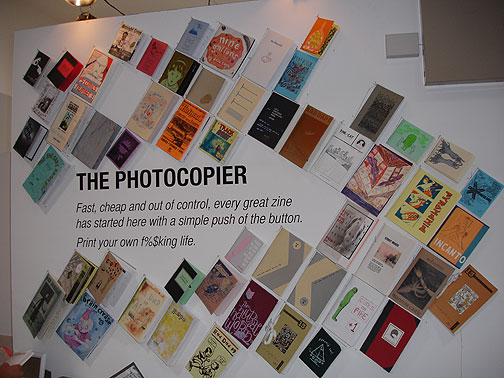
Few of these were actually created at the workshop, but they had 'em displayed to encourage free use of their copier.
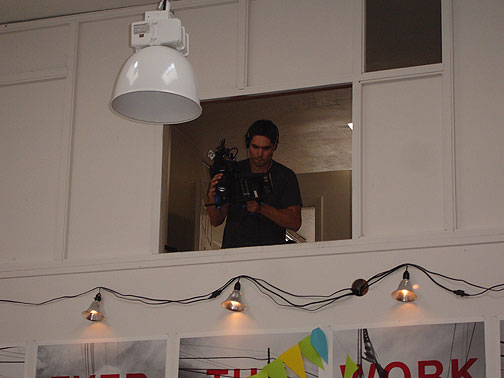
The payoff for Levi's: This guy was shooting while I was taking photos. First he was roaming among the various "workers" and then he went upstairs to get this overview shot...
Hardt and Negri describe the problem of capturing the immeasurable wealth, which maybe this Levi’s workshop is managing to do.
“Furthermore, the results of biopolitical production, including social subjectivities and relations, forms of life, [do generate] value, but it is immeasurable, or rather it constantly exceeds the units of any accounting scheme; it overflows the corporation’s double-entry ledgers and confounds the public balance sheets of the nation-state. How can you measure the value of an idea, an image, or a relationship? The quantitative indicators of professional economists offer little “¦ in particular since production of the common constantly exceeds not only relationships of control but also frameworks of measure. Useful economic indicators instead would have to be qualitative.”
“Join us, roll up your sleeves, and get to work.” They have a half dozen slogans like this. Another one is “Ready to Work” echoing the millions of unemployed who would be glad to get a job rather than being thrown on the discard pile like they were a broken piece of plastic. Yet another version is splashed across big billboards near the Bay Bridge: “Made Strong for the New Work,” with three men wearing the requisite branded clothing while posing among machines and in brick rooms as though waiting for them to come back to life. What is this “new work”? One guy stands in front of an out-of-context motor in an otherwise empty room. The guy on the right is sitting on an old motorcycle in another empty room, probably a former factory work space. The guy in the middle is walking through some kind of archway with a cityscape behind him” is he entering an empty factory or leaving a dying city? These guys aren’t working exactly, they’re waiting. They’re embodying the precariousness of modern worklife, a dangerously accurate portrayal of the lassitude and emptiness that fills all too many lives in an economy with 22% unemployment. Waiting for the New Work that hasn’t yet started, or if it has, only in brief fits and starts, enough to keep you from total penury, maybe even enough to keep the payments going on the credit card where you charged the new Levi’s you bought, or so the ads imply”¦
But precarity is a permanent state now. The lost world of full-time work for stable employers actually making things that other people can use and will buy, is now reduced to phantom references floating in and around an ad campaign. The images are meant to invoke a (false) sense of nostalgia, but one that has a real yearning in it, a persistent wish for a stability and security that were never available to most of the world and only to a fraction of the American working class during the peak of U.S. global power. That time is definitively over.
But in good old American bootstrapping ideology, Braddock is being showcased as an example of the can-do spirit, the circular fantasy that once you’ve been kicked to the ground by the decisions of a tiny elite who control wealth and power, you can work yourself to the bone to regain your former middle-class comforts. I’m pretty sure Mayor Fetterman, who looks like he was part of Survival Research Laboratories or some equally edgy urban art project (and is an Ivy League grad to boot), knows better. The Braddock website features a stark and gritty urban aesthetic but has a photo of a big urban garden as the first thing you see, with the slogan under it, “Reinvention is the only option.”
So if you were the Mayor of Braddock, or even just someone who moved there to be involved in a radical effort to reinvent the place, how would you respond to the sudden appearance of a major corporation who offers serious money with the only caveat that they can make and use representations of you for their own marketing purposes? Not an easy call. Because anyone facing that level of economic collapse and urban decay knows that they need serious resources to get out of the hole. You can only bootstrap yourself so far, and without serious capital (in this culture) to work with, you’ll probably hit a wall.
Obviously Levi’s is co-opting Braddock and its Mayor. Does that mean he’s lost all autonomy and is now a fully captured entity of Levi’s? I doubt that too. Maybe he thinks he’s playing Levi’s and as long as their money stays in the buildings and facilities they’ve invested in, Braddock comes out way ahead no matter what dumb advertisements Levi’s runs for a few months or even a year or two”¦ Time will tell for Braddock’s gamble.
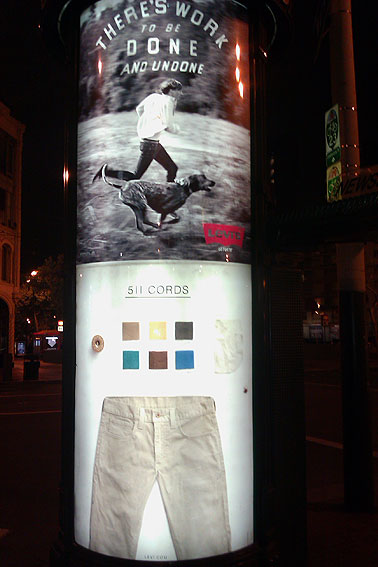
Here's another weirdly edgy slogan: There's Work to be Done and Undone! Whew! That's putting it mildly... how about we eliminate advertising, insurance, banking, real estate, military production.... for starters?
But here in San Francisco, the naïve young hipsters who are flocking to the Levi’s store are doing what comes natural. They’re playing, they’re making art, they’re finding friends and community in practical projects that are based on their own sense of meaning and purpose. Wouldn’t it be lovely if we always had access to practically unlimited resources to make our zines, our posters, our t-shirts, our creative fantasies? Why don’t we have such workshops as a matter of course? And not limited to printmaking and clothing, but a whole range of tools and machinery so we could begin to make the world we want to live in, a world of our own design? Levi’s is tapping that yearning, but will soon pull it all away, just like Lucy always pulls away the football just as Charlie Brown is really ready to give it the kick of his life.
Hardt and Negri say “the metropolis is to the multitude what the factory was to be the industrial working class”¦ the metropolis primarily generates rent, which is the only means by which capital can capture the wealth created autonomously.” And it isn’t coincidental that during the past two years of economic breakdown, mass foreclosures, and rising unemployment, San Francisco rents have remained in the stratosphere. Aggregate capital is doing a fine job of exploiting the flourishing, unmeasurable creative output of San Francisco’s residents through the harsh regime of rents here. Now we have Levi’s opening a temporary workshop to experiment with a new form of cooptation, simultaneously more overt and more opaque, more insidious and more subtle. How will this play out? Can we turn this inside out? Or does it automatically turn us inside out? Love to hear your thoughts…

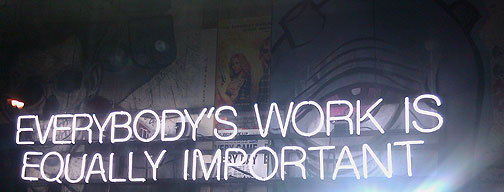
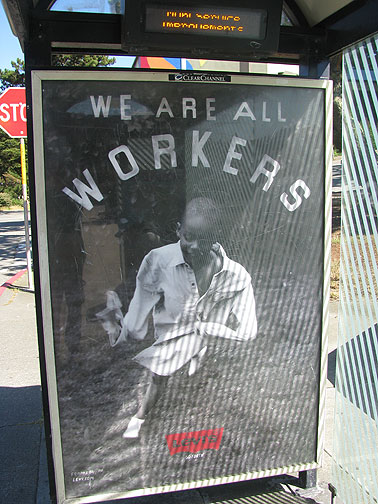
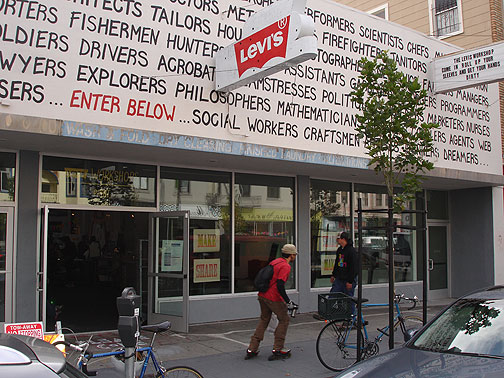
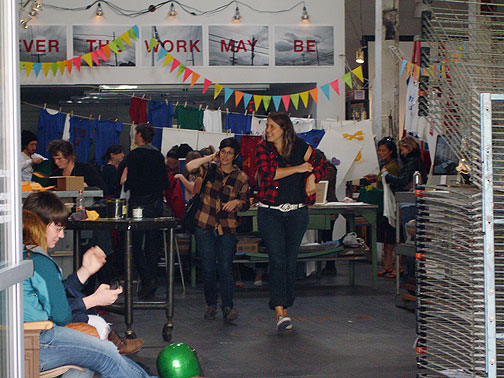
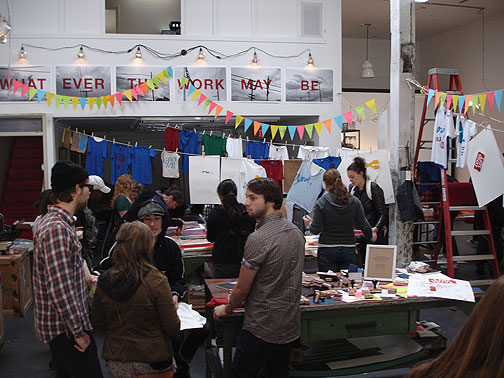

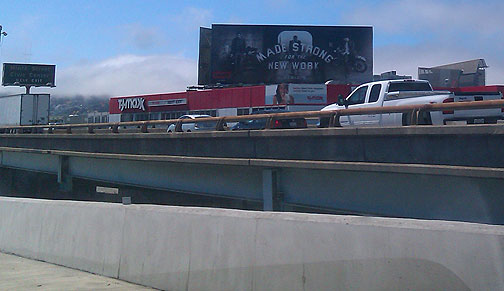
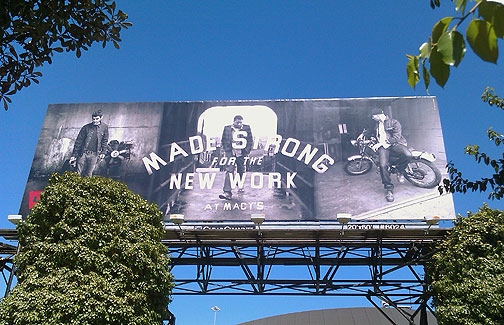











Hi, I’m a printer who was nearly hired by the Levi’s workshop and left before they ever opened. I will be in touch with you soon. Hopefully will be presenting on this at the APHA conference this year.
Lara
I spent really nice time reading yours articles. I’m happy that I step in right here.
This is from my old friend Doug Minkler, who encouraged me to post it here:
To:Â Levi Strauss & Co.’s Workshop Artists
Fr: Â Doug Minkler
Re: Â Lay Down Your Brushes
Levi Strauss & Co., Wal-Mart’s largest worldwide strategic partner, is just finishing a two-month long advertising event in San Francisco via their Levi’s Free Printing Workshop. Â Artists from as far as Sacramento and the East Bay have made their way to the workshop to be part of the giant Levi Strauss advertisement campaign. Â The colorful and talented artists are not printing Levi’s logos, rather, they are printing their own art work. Many of the artists, especially the activists, would never consider creating advertising for the corporate giant, but that is exactly what they’ve done. Â Some justify their new relationship with Levi by working on their own projects that benefit non profits, others claim they have not been duped because they are addressing social justice issues on Levi’s tab. Â A Levi’s workshop exhibit of well known activist artists titled “Mission Icons In Time Of Change” emerged from the Free Print Workshop in order to raise much needed funds for Plaza Adelante, a Mission self-help center for lower and middle class Latino families. Â So, what could be wrong with artists and the community finally getting a piece of the corporate pie? Â I fear a lot.
Artists who accepted the free printing are tacitly saying to both the Levi Srauss corporation and the public that “Levi Strauss can use us for cleansing their reputation–their exploitative corporate labor and marketing practices are okay with us. Â Give us free printing and we will help you sell jeans and a false benevolent image”. Â Levi’s co-optation of the artists’ positive image is accomplished by masking corporate advertisement with the legitimizing appearance of involvement in social justice efforts and philanthropy. Â In Levi’s cloaked sales campaign, artists are kept far removed from the crass tactics involved in sales, consequently, artists are lulled into thinking that they have not compromised their principles. Â For the corporation, it is a “win win” situation, but for the non-commercial, Â artist, the “For Sale” jacket they now wear is a problem.
I believe a more critical look at Levi Strauss & Co. is in order before more artists enter into a casual (or not so casual) relationship with this corporate giant.
1. Â Levi Strauss & Co. is a worldwide corporation organized into three geographic divisions: Â Levi Strauss Americas (LSA), based in the San Francisco headquarters; Levi Strauss Europe, Middle East and Africa (LSEMA), based in Brussels; and Asia Pacific Division (APD), based in Singapore.
2. Â By the 1990s, the Levi brand, facing competition from other brands and cheaper products from overseas, began accelerating the pace of its U.S. factory closures and its use of offshore subcontracting agreements. Â In 1991, Levi Strauss faced a scandal involving six subsidiary factories on the Northern Mariana Islands, a U.S. commonwealth, where some 3% of Levi’s jeans sold annually with the Made in the U.S.A. label were shown to have been made by Chinese laborers under what the United States Department of Labor called “slavelike” conditions. Â Today, Levi jeans are made overseas. Â Cited for sub-minimum wages, seven-day work weeks with 12-hour shifts, poor living conditions and other indignities, Tan Holdings Corporation, Levi Strauss’ Marianas subcontractor, was forced to pay what were then the largest fines in U.S. labor history, distributing more than $9 million in restitution to some 1,200 employees.
3. Â The activist group Fuerza Unida (United Force) was formed following the January 1990 closure of a plant in San Antonio, Texas, in which 1,150 seamstresses (primarily Hispanic women [citation needed]), some of whom had worked for Levi Strauss for decades, saw their jobs exported to Costa Rica. [12] Â During the mid and late 1990s, Fuerza Unida picketed the Levi Strauss headquarters in San Francisco and staged hunger strikes and sit-ins in protest of the company’s labor policies. [13][14][15]
(The above three historical facts about Levi Strauss were resourced from Wikipedia.)
If Levi’s labor practices are not enough reason for you to end your association with them, possibly their recent sexist, homophobic DOCKERS campaign encouraging men to “Wear the Pants” and welcoming people to “MAN Francisco” will, or their “All Asses Are Not Created Equal” ad emphasizing variation in butt sizes but continuing to bombard women with images of the unattainable Barbie shape will, or perhaps their ever increasing sexualization of younger and younger girls via their skin tight low rider jeans will, or “all of the above” will.
In the 90’s, I taught printmaking in the mission at New College of California. Â One day my class was asked by the administration to create a poster for SF Poetry Week. Â The first question the students asked me was who were the sponsors? Â When I informed them that the sponsors were Levi Strauss, Nestle’s and New College, they not only refused the job, but produced protest posters against their college’s involvement. Â Next, they produced a series of posters that exposed Levi’s U.S. plant closures, their off-shore labor practices and Nestle’s deadly infant formula peddling. Â These images were either wheat-pasted in San Francisco or hung in the coffee shops in which the poetry events occurred. Â My refusal to stifle the students’ anger and sense of justice eventually cost me my job.
I am not surprised by Levi’s latest marketing ploy. Â What I am surprised and disappointed about is how easily such a large number of artists were seduced. Â To my fellow artists, who oppose the capitalist/corporate model of production and who became artists for reasons other than money, I recommend that you re-evaluate your association with this corporate sponsor and then withdraw your participation.
Doug Minkler
If so inclined, please circulate widely, respond to dminkler@dminkler.com, to Letters to the Editor or the publication/blog of your choice.
I saw the ad with the kid wearing a work shirt & the first thing I thought of was child labor.
“Everybody’s work is equally important” – is that supposed to be a goddam joke? That is an out-and-out lie – the frustration of life is that the work that we could deem important we cannot do – not in this supersystem.
And in one of the more insidious codas to this – corporate advertising is tax deductible. We pay, through our taxes, for Levi’s to benefit from this ad campaign. They write off the cost of the ad campaigns out of their profits, so it ends up costing them next to nothing, we pay through income and sales taxes what they get in tax deductions – what a system. Not being an accountant, I’m not sure how the whole thing works to the last dime, but I’d leave it to some million-dollar employee to prove my research wrong.
Thanks for the brilliant heads-up.
What “work”? All I see here is a myth, a glamorized vision of “work” and “the worker”, not unlike Soviet propaganda. Yeah, “make art”, make your own zine, and label yourself a worker… and by all means, keep buying clothes and electronics made by third world factory workers, keep eating vegetables picked by underpaid migrant field laborers, keep enjoying cheap meals made by exploited hands, keep having your houses/offices cleaned by impoverished women of color… Oh and let’s not label “work” the invisible labor women do in the privacy if the household.
There’s the glamorous worker: rough, proud, wearing jeans, boots, metal, and there’s the really uncool worker who will never be glamorous enough to be featured in a Levi’s ad campaign!
American work ethic propaganda is an efficient brainwash. What I see is people without capital getting screwed and exploited, working long hours for what? Even well intentioned people buy into the myth. And so many workers don’t seem to question the value and meaning of “work”/their work.
Also, I agree with you Chris: *not* all work is equally important. Lobbyists? Nuisance. Pharmaceutical propagandist? crooks. Ad agencies? Liars. Walmart director? social plague. etc. etc. etc.
Last thing: WTF is that poster with the kid supposed to be? A black child running and the caption “we are all workers”… What?
I like to imagine that Levi’s is working behind the scenes to create a sense of pride with the lower class and undereducated. I’ll grant that the campaign is strangely communist and shocking because of it’s blatant manipulation of the DIY trend, but perhaps it’s possible that the subliminal messaging will create positive change where it’s needed.
Maybe I’m just being optimistic.
it would be more impressive if they actually followed their new marketing idea of helping out the “worker” in tough economic times by reopening the factory down the street that was shut down in 2002
I find the “We Are All Workers” ad with the obviously underage boy wearing an oversize shirt particularly disturbing; it desensitizes people to the idea of child labor.
“space/resources like this to a community” should belong to the community. Those corporations that ‘cares’, such as Levis, aught to spend their lobbying$s advocating for public spending, more equitable wealth distribution, higher taxes and policies that actually benefit the public. I see this ‘creation of (public) space’ as problematic as philanthropy, it’s about maintaining control of where, when and how resources are distributed in the hands of the few. The rest are like kindergartner who are allowed the liberty to play, in the designated sand box for a half hr after lunch, if they behave.
This is less about whether we have resources/space to express ourselves, or how long it stays open, it’s a question of having control over our own lives or be content to plug-n-play where allowed. I feel that once the connection is made, it becomes impossible to uncouple. Say if Braddock truly becomes revitalized, Levis will forever have a (soft) claim to the hard work and ingenuity of that community – for marketing purposes, for goodwill, for justification… kind of like women’s liberation is still, unfortunately to some, symbolized by cigarette smoking decades later. British public’s reaction to BP spill came also to mind – their pensions were invested in it. Are we still autonomous actors when each of our actions furthers, or becomes an (unintended) endorsement to, a distant entity? If we should disapprove of such entit(ies), to which we are linked, are the only options left inaction or destructive ones?
Thanks, Chris!
Just a few questions: 1 – How far did things go beyond “suspicious”? 2 – Did Levi’s expect and get some subvertisment? In other words, even incorporate it into its schtick? (My favourite related examples of this: Dr Evil’s HQ in an Austin Powers movie was Starbucks Coffee, of course with their permission.. and also, closer to the sartorial subterfuge you talk about, is this gem of co-opting from a few years back.) . If someone at the workshop did something clearly against them, Levi’s would just assume the gracious state of a… State, and say that it respected free speech. 3 – Is this “Culturewashing” or “Scenewashing”?
Â
This ad campaign has really been getting on my nerves! “Everybody’s work is equally important”–let them say that to their sweatshop workers who are paid a fraction of what their CEO is paid!
thanks chris, it does seem like such a positive idea and impulse from them? it may be possible that there does exist a corporation out there willing to do something like this properly…offering space/resources like this to a community on a longer term basis, a company willing to invest in people’s creative talent in a way that truly benefits (and respects) both groups needs? corporations are not completely artificial/alien creations are they?